🐔 Chicken Coop Run + Garden Design: 7 Clever Ways to Keep It Cohesive

Are Your Chicken Coop and Garden at Odds?
If you’ve ever looked out into your backyard and thought, “Why does my chicken run look like it belongs in another world?” — you’re not alone. For so many of us trying to live that backyard homestead dream, our chicken coop run becomes the “eyesore” in an otherwise charming garden. I used to feel the same. My raised garden beds were thriving, flowers blooming… and right in the middle was a mismatched coop that looked more like a shed than part of my design vision. But with a little creativity, I discovered ways to make the chicken run blend beautifully into the garden, making the whole space more serene, functional, and — honestly — way more Pinterest-worthy.
Let me walk you through 7 clever ideas that helped me turn my coop + garden chaos into one calm, cohesive backyard dream.
Free PDF Popular Thai Stir-Fry Menu Ideas Download Here :
Learn 1 Stir-Fry Sauce Base That Most Thai Restaurants and Thai Families Use to Combine Unlimited Stir-Fry At Home
🐔 1. Use Matching Natural Materials
If you’ve ever walked into your garden and felt like your chicken coop looks like it crash-landed from another planet, you’re not alone. That was exactly how I felt the first spring after I installed my chicken coop. My raised beds were framed in beautiful cedar, my pergola was wrapped in blooming jasmine, and then — BAM — a bright orange plastic coop with metal fencing stuck out like a sore thumb. It felt functional, sure, but not like something that belonged in my peaceful, natural garden space.
That’s when I realized: the secret isn’t building something new — it’s making what you already have feel intentional. The easiest way to make your chicken coop run blend into your garden is by using the same natural materials you’ve already used in your garden design. That means matching woods, repeating elements, and layering textures that echo the beauty of your planting areas.
For me, that meant covering my coop frame with reclaimed cedar boards — the same ones I used to build my raised beds. I also replaced the glaring metal fencing with hardware cloth framed in timber to give it a softer, organic feel. The transformation was immediate. Suddenly, the coop wasn’t an outlier. It felt like part of a thoughtful garden plan — a destination, not an eyesore.
Other great materials to consider? Woven willow panels for a rustic cottage look, bamboo for a breezy Zen vibe, or even stone borders around your coop’s base to echo garden paths or retaining walls. You could also add rattan baskets for feed storage or a wooden crate for fresh eggs — bonus points if you already use these touches in your garden seating area.
When your chicken coop run uses the same natural elements as your backyard garden, it creates visual harmony — and that makes the space feel bigger, more intentional, and more enjoyable to be in. You’ll go from avoiding that side of the yard to showing it off.
And remember, you don’t need to overhaul your whole setup. Even swapping out one or two elements — like the fencing or trim — can dramatically improve the cohesion between your chicken coop and your garden design.
🌿 2. Add a Living Roof to the Coop for Beauty and Function
I’ll be honest — I didn’t originally plan to put a living roof on my chicken coop. I saw it in a magazine once, thought it looked way too “Instagram-perfect,” and assumed it would be too much work. But after battling the visual awkwardness of my coop in the middle of my flowering backyard and getting tired of looking at a flat, dull roofline, I decided to give it a try. Best. Decision. Ever.
Adding a living roof to your chicken coop run doesn’t just make it look stunning — it integrates the coop into your garden landscape in the most natural way. Suddenly, the coop stops looking like a utility box and starts to resemble a charming garden feature. And here’s the fun part: it doesn’t have to be complex or expensive. I used leftover wood to build a shallow tray on top of the coop and filled it with a mixture of succulent-friendly soil and chicken-safe plants like sedum, creeping thyme, and even some lavender.
From there, the magic happened. As the plants filled in, they softened the hard lines of the structure and visually “tied” it into the rest of my herb garden. Every time a breeze caught the lavender and sent its scent drifting across the yard, it felt like I had stumbled into a storybook. Not to mention, it made the coop cozier and better insulated, helping regulate the temperature inside throughout the year — a bonus my hens definitely appreciated.
A living roof works especially well if your garden already includes climbing plants, wildflower patches, or layered vertical design elements. It encourages bees and butterflies to visit, and helps absorb rainwater — making your setup not only prettier but also more eco-friendly.
The key to success? Choose low-maintenance plants that thrive in shallow soil and partial sun. Avoid anything too thirsty or invasive. And make sure your coop roof can hold the weight of the soil and plants (a basic reinforced tray is usually enough for small setups).
If you’re serious about creating a chicken coop run that blends beautifully into your garden, the living roof is a show-stopping, practical way to do it. Every time someone comes over, that’s the first thing they notice — and I always get to say, “Yep, that’s my chicken coop.”
Let your coop be part of your garden’s charm — not a distraction from it.
🌸 3. Frame the Coop Run with Raised Beds and Edging
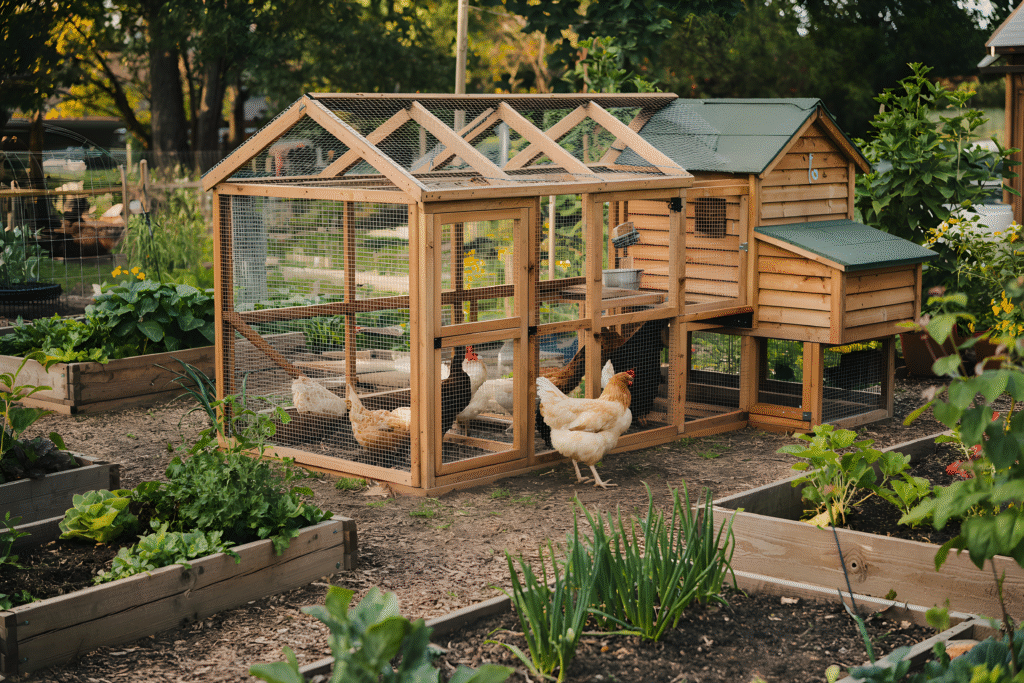
One of the simplest and most impactful ways to visually integrate your chicken coop run into your garden design is to literally build the garden around it. After struggling for months with how to soften the industrial look of my chicken wire fence, I had an aha moment: frame it with plants. And not just any plants — use raised garden beds.
I built two rectangular cedar planters that mirrored the dimensions of my chicken run. I filled them with herbs, perennials, and flowering pollinators: rosemary, echinacea, calendula, marigolds, even chamomile. Suddenly, the wire fencing that once screamed “pet enclosure” was now surrounded by soft greenery and color.
Raised beds bring cohesion by making the coop feel like it’s intentionally part of the garden layout. Instead of a separate, standalone feature, the run becomes a garden centerpiece. The visual lines between garden and coop blur beautifully — and the bonus is, those herbs? Chickens LOVE to nibble on them. And they deter pests too. Nature wins again.
You don’t need a lot of space either. Even in small yards or urban backyards, low-profile planters or even container gardens lined along the base of the coop can create that same effect. Don’t forget to edge the run itself! Brick, stone, or even painted wood edging around the coop path makes the transition feel seamless.
Design tip: choose plants that complement the color of your coop. If your coop is gray, try silvery lamb’s ear and lavender. If it’s natural wood, go for rich greens and whites to soften the look.
By framing your chicken coop with raised garden beds, you’re not only adding functionality and charm — you’re creating flow. And once that flow is there, your backyard starts feeling like a retreat, not a utility zone.
🎨 4. Paint or Stain for Visual Unity
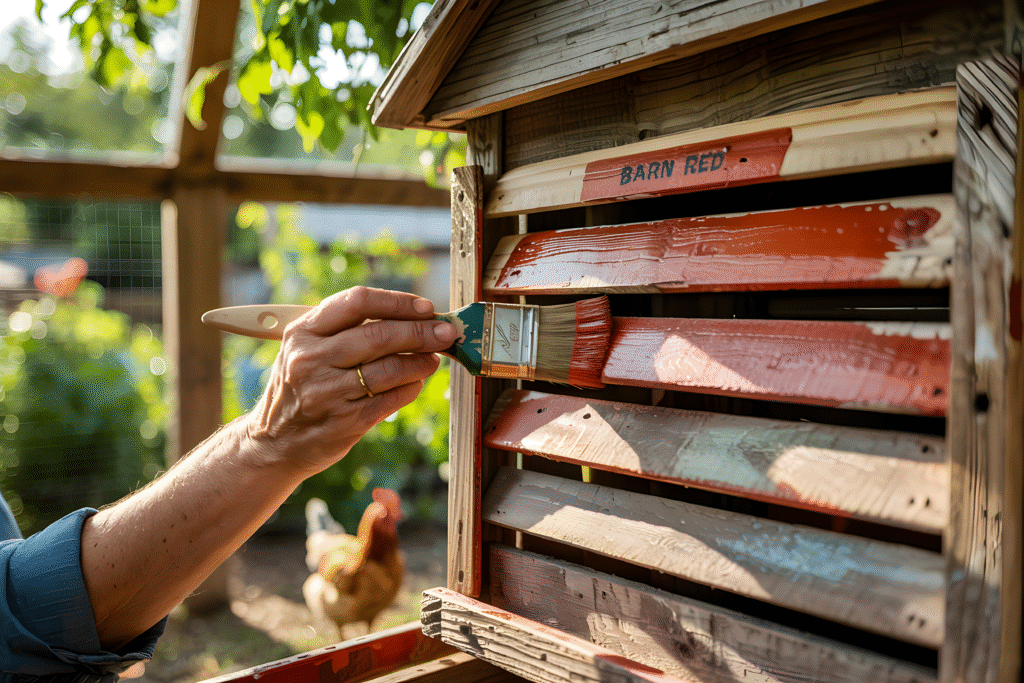
I used to think painting the chicken coop was pointless — I mean, it’s a chicken house, right? But then I realized something: I painted my fence. I stained my deck. I even repainted my garden shed. Why wouldn’t I do the same for the coop that sits in the center of my backyard?
The colors you use in your garden decor and landscape structures set the tone for the whole space. So if your coop stands out like a sore thumb — or just doesn’t match the rest of your garden — it can throw off the whole vibe.
When I finally painted my coop the same soft sage green as my planters, it was like magic. Suddenly, the garden felt cohesive and deliberate. The chicken run wasn’t the awkward cousin at the garden party anymore — it was the co-host.
Choose a color that already exists in your garden — the trim on your windows, the pergola, your patio chairs — and use it for the coop. You can even use complementary tones: think creamy white, dove gray, navy, or dusty blue. These hues are not only garden-friendly but also timeless.
If you prefer natural finishes, staining the coop to match your raised beds or fencing can bring that organic, rustic feel that blends with nature beautifully. Just make sure the paints or stains are non-toxic and animal-safe.
And don’t stop at just the exterior — think about the details: flower boxes under the coop window, a matching door handle, even a hanging sign with your flock’s name. The small details turn the coop into a design element — not just a shelter.
Color is powerful. Use it to tie your garden and chicken coop together, and suddenly your whole yard becomes a reflection of your style.
🌺 5. Use Plants as Soft Screens Around the Chicken Run
Let me tell you a secret — plants can fix almost anything when it comes to backyard design. And when your chicken coop run looks too exposed, too stark, or too “chicken coop-y” next to your lush flower beds and winding garden paths, the solution might be simpler than you think: plant a living screen.
When I first installed our coop, I kept getting this nagging feeling. The garden was soft, romantic, almost dreamy. Then there was the run — all angles and metal. My husband called it “the chicken jail.” Not exactly the look I was going for.
So I did what gardeners do best — I planted my way out of the problem. I started with climbing jasmine and sweet peas on trellises at the back of the coop. On the sides, I added flowering shrubs — hydrangeas, spirea, and even a small lilac bush. Within weeks, the harsh edges of the run were blurring, and the coop was slowly becoming part of the garden story.
Using non-toxic plants that are safe for chickens is crucial, of course. But you’ll be surprised how many beautiful options you have. Think hollyhocks, nasturtiums, lavender, marigolds, or even herbs like rosemary and thyme. Not only do they look gorgeous, but some also repel pests — a win for you and your hens.
You can go vertical with trellises, arbors, or wire panels wrapped with vines. Or go horizontal by planting dense rows of low-growing perennials that hug the edge of the run. Either way, you’re softening the coop visually and making the space more inviting.
If you have a small garden, don’t worry. Even just a few potted plants placed strategically around the coop can create this effect. Use matching pots, weathered wooden crates, or even old galvanized buckets to tie into your garden’s overall style.
What I love most about using plants as a natural screen for your chicken coop run is that it feels alive. It changes with the seasons. In spring, you get fresh color. In summer, lush green. In autumn, golden foliage. And all year long, your chicken area feels like a hidden garden nook, not a fenced-off utility zone.
And guess what? Chickens love it too. Mine now dust bathe in the shade of the hydrangeas and nibble the ends of the herbs. It’s become part of their world — and mine.
Free PDF Popular Thai Stir-Fry Menu Ideas Download Here :
Learn 1 Stir-Fry Sauce Base That Most Thai Restaurants and Thai Families Use to Combine Unlimited Stir-Fry At Home
🪴 6. Coordinate Pathways and Ground Cover for Seamless Flow
If there’s one design tip that changed the entire feel of my backyard, it’s this: treat your chicken coop run like it’s part of your garden path system — not the place where the path ends. This single shift in mindset helped me finally unify the look of my garden and chicken area without building anything new. Just adjusting how we walk through the space made all the difference.
Let me paint a picture: my original garden path was charming. Flagstone pavers, creeping thyme between the cracks, winding through my herbs and flowers. Then, it hit the edge of the chicken run — and turned into plain, dusty dirt. It looked unfinished, like someone ran out of ideas. Honestly, it made the coop area feel neglected. My husband even joked it was like stepping into “the utility zone.”
So I fixed it. I extended the same flagstone path into the chicken run gate, wrapped it around the nesting boxes, and added a second path looping back to the compost bin. I lined the edges with gravel and added stepping stones where the ground was too uneven. Suddenly, the entire area felt intentional — like part of the garden layout, not just the back corner where we stashed the chickens.
This works no matter what kind of garden path you have. If you use crushed gravel, mulch, pea pebbles, or bricks — extend that same material around the coop run. If you’ve used edging elsewhere, use it here too. Even a row of decorative bricks or weathered logs can make a big difference. The goal is visual flow — your eyes and feet should travel smoothly from one part of your garden to the next.
Don’t forget ground cover plants, either. In shady areas around the coop, I planted creeping Jenny and woodland phlox. In sunnier spots, I added low-growing chamomile and strawberry plants. Not only do they soften the path visually, but they also add function — and in some cases, snacks for the hens!
This kind of detail might seem small, but it elevates the entire experience of being in your yard. Instead of awkward transitions and disjointed zones, you create a backyard that feels thoughtful, connected, and completely charming. It turns your chicken coop area into a destination, not just a functional stop.
If you’re building a coop for the first time, this is something you can design into your plan early. If you’re retrofitting an existing setup like I was — start with a weekend, a few bags of gravel or stepping stones, and a vision for how you want your garden to flow. Trust me, you’ll feel the difference the moment you take your first walk across it.
🎀 7. Add Decorative Touches That Match Your Garden Style
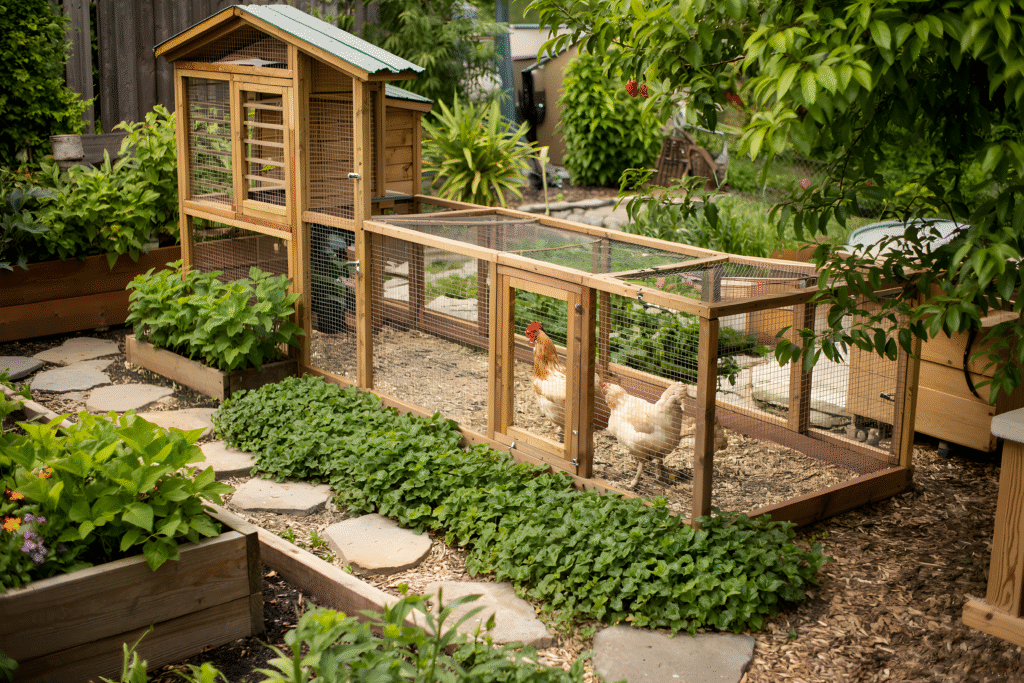
Let’s be honest — we decorate our patios, our sheds, our garden gates… so why not our chicken coop runs? This is where your creativity gets to shine. Once the major building is done, adding decorative, personal touches is what truly brings your chicken run and garden design together. It’s not about being fancy — it’s about being intentional. And let me tell you, the first time I hung a flower basket on the side of my coop, I stood back and thought, “Why didn’t I do this sooner?”
When your garden has a clear style — whether it’s rustic cottagecore, modern minimalist, farmhouse chic, or boho wild — echoing that in your chicken area instantly makes everything feel unified. And the best part? You can start small. Decorative details don’t have to be expensive or overwhelming to make a huge visual impact.
In my case, I already had an herb spiral, a rattan egg chair, and vintage enamel watering cans throughout the garden. So I leaned into that style. I added a faded wooden sign above the nesting box that says “The Ladies’ Lounge.” I wrapped the coop fence in solar fairy lights and added a hanging flower basket filled with trailing petunias. I even tucked a little ceramic garden gnome just outside the coop gate. And yes — it makes me smile every single time I see it.
If you love modern design, go for sleek lines and clean tones — maybe black metal signage, geometric trellises, or matte black water feeders. If you’re into cottage garden style, hang lace curtains inside the coop windows, use vintage teacups as planters, or attach a shelf with potted lavender right outside. The key is to echo what you already love about your garden elsewhere — just extend it to the coop.
Here are a few more decorative ideas to get your creative gears turning:
- Hang up a chalkboard or reclaimed wood sign with your flock’s name
- Add window boxes to the coop filled with flowers or herbs
- Use decorative stones or mosaic tiles around the base of the run
- Place a vintage bench or crate nearby to sit while watching your hens
- Paint the coop door a charming accent color to match your garden gate
The magic is in the repetition. Use the same colors, materials, and motifs that already exist in your backyard. These decorative chicken run details aren’t just cute — they’re what make your outdoor space feel like home.
It’s amazing how a few thoughtful items can transform your coop from “just a structure” into a conversation piece. Guests notice. Kids love it. And your garden starts to feel more like a retreat — even in the chicken zone.
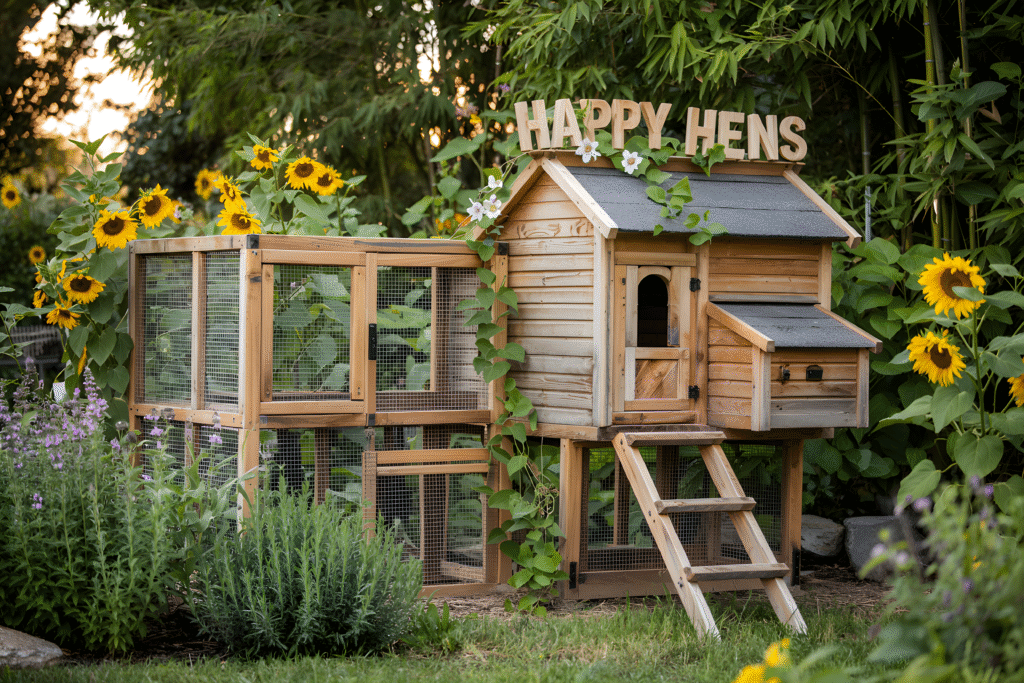
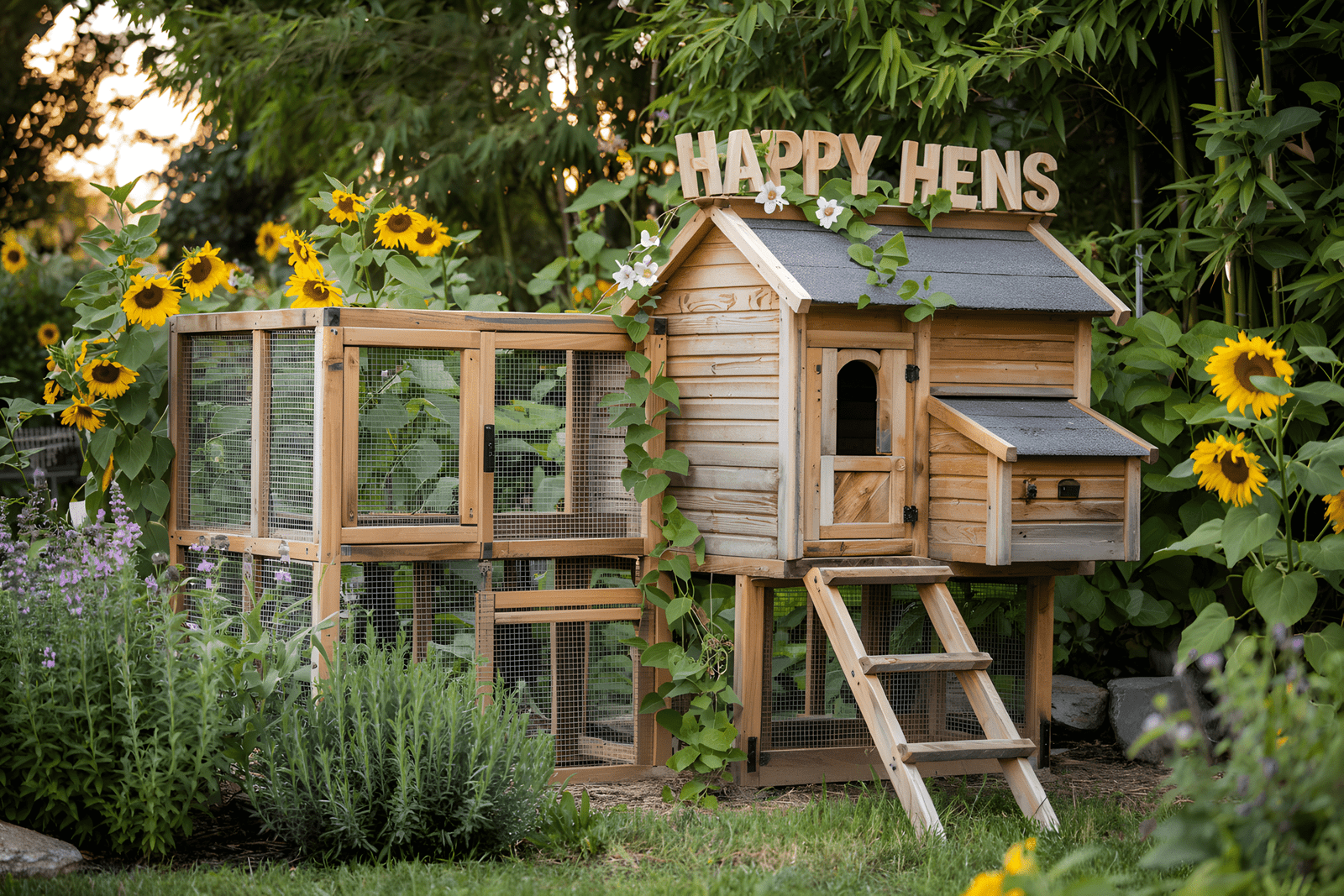







2 thoughts on “🐔 Chicken Coop Run + Garden Design: 7 Clever Ways to Keep It Cohesive”
Comments are closed.